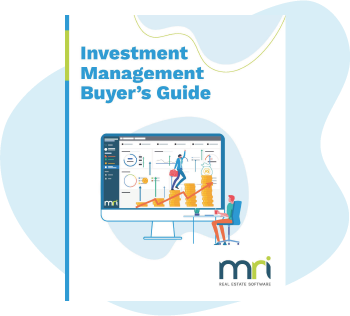Real estate investment data analysis: Unlocking hidden opportunities for asset managers
In real estate investment, data is the most valuable asset. As an asset manager, you rely on data to make informed decisions, identify market trends and maximise returns. It’s been shown that asset managers and real estate companies that use big data effectively can reduce risk by 30%.
But simply gathering comprehensive data isn’t enough. The real power lies in your ability to analyse that data effectively. By uncovering patterns, forecasting potential risks and identifying emerging opportunities, data analysis helps you optimise your investment strategy.
In this post, you’ll learn how you can use real estate investment data analysis to drive better outcomes for your portfolio.
The importance of real estate data analytics
All investors and asset managers need accurate, current information to decide when to buy, sell or hold assets. By incorporating big data analytics in real estate into your investment strategy, you can:
- Predict future trends and shifts in demand.
- Identify potential risks early, enabling better mitigation strategies.
- Accurately assess property values based on historical and real-time data.
- Make data-driven decisions to maximise returns and minimise losses.
- Allocate capital and resources more effectively by understanding market dynamics.
- Continuously monitor and improve the performance of your investment portfolio through data insights.
Without data, you risk relying on gut feelings or outdated information. Using data science real estate investing tools removes uncertainty from your investment strategies. You can base your decisions on facts and patterns, ultimately maximising your portfolio’s performance with precision.
What is data-driven real estate investing?
Data-driven real estate investing uses quantitative and qualitative data analytics to inform your investment decisions. By analysing a range of data points, you can better understand market dynamics, property performance and future growth potential.
Quantitative data includes metrics including property price trends, rental income, vacancy rates, cap rates and market supply and demand. On the qualitative side, you’ll assess factors like tenant reviews, property conditions, community reputation and local economic conditions.
The true power of data-driven investing lies in combining these insights to guide your strategy. By using both data types and applying effective analysis, you can make more informed decisions that lead to greater short-term gains and sustained long-term portfolio success.
How asset managers use data to identify trends and opportunities in real estate
Data-driven real estate investing helps you identify emerging real estate trends and opportunities. By analysing key data points, you can identify shifts in market demand, evaluate property performance and make strategic decisions that optimise your portfolios. This data-driven approach enables you to stay ahead of the competition.
For example, if you’re analysing tenant reviews for a property in a suburban area with a declining community reputation, it might appear to be a poor investment opportunity. Negative feedback about safety concerns or deteriorating amenities could deter potential renters or buyers, signalling a higher vacancy risk. Based on this qualitative data alone, the investment might seem too risky.
Data-driven real estate investing doesn’t just analyse one type of data or data in isolation. When you combine this information with rental income trends, you might discover that despite the negative reviews, rental prices are steadily increasing due to high demand in the surrounding areas. This shows how assessing both qualitative and quantitative data can reveal a hidden opportunity, turning what seemed like a poor investment into a profitable one.
The role of technology and advanced analytics
Machine learning, predictive analytics and artificial intelligence (AI) are transforming the way you approach real estate investing. These technologies can process vast amounts of data, identify patterns and provide insights faster and more accurately than traditional methods.
In real estate data analytics, AI and machine learning can help you automate data collection and analysis, enabling you to make quicker, smarter decisions. Predictive analytics let you model future scenarios, such as market shifts or property appreciation, based on historical data. This level of insight empowers you to mitigate risks and optimise your investment strategy for better returns.
Implementing data-driven real estate investment strategies
Implementing a data-driven real estate investment strategy requires the right combination of reliable data, advanced tools and structured processes. By following a clear, step-by-step approach, you can effortlessly integrate data-driven techniques into your asset management.
Step 1: Gather reliable data sources
To effectively implement a data-driven strategy, you must first gather reliable data such as property prices, rental income, vacancy rates and neighbourhood demographics. This ensures you have accurate information for decision making.
MRI Software’s real estate investment management software simplifies data collection by offering access to real-time data, automated reporting and detailed market insights. This comprehensive system ensures that your data is always accurate and up to date so you can make informed investment decisions confidently.
Step 2: Use analytics tools
Using advanced analytics tools helps process both quantitative and qualitative data, allowing you to uncover trends and predict future market behaviour.
Our software integrates machine learning and predictive analytics, which can help you analyse vast amounts of data and provide actionable insights. These tools let you identify emerging trends, forecast property values and make data-backed decisions that enhance your portfolio’s performance.
Step 3: Set KPIs and track performance
Tracking key performance indicators (KPIs) like ROI, occupancy rates and cash flow ensures your investments align with your goals and enables you to measure ongoing performance.
Our platform provides you with automated KPI tracking and customisable financial reports, giving you a clear picture of your portfolio’s health. With these tools, you can monitor progress regularly and adjust based on performance.
Step 4: Adjust strategy based on insights
As market conditions change, continuously adjust your investment strategy. Use the data to identify new opportunities or mitigate risks, ensuring that your portfolio remains optimised for long-term success.
With dynamic scenario planning and in-depth portfolio analysis, you can adapt quickly to market shifts. These insights can enable you to seize new opportunities, mitigate risks and optimise your portfolio for long-term success.
Overcoming challenges in data analytics for real estate investing
Despite the advantages, data analytics presents challenges. One major issue is data fragmentation. Real estate data often exists across multiple platforms, making it hard to gather and analyse effectively. This can result in incomplete analyses that impact decision making.
Another challenge is ensuring data quality. Not all sources are reliable and poor-quality data can lead to incorrect conclusions. It’s crucial to vet your data sources, ensuring the information is accurate and relevant to your investment goals.
Tips and solutions to overcome these challenges
Now that we’ve pinpointed challenges like data fragmentation and inconsistent data quality, the next step is figuring out how to tackle and overcome them. Fortunately, there are effective solutions to move beyond these obstacles, enabling you to fully harness the power of data analytics.
Centralise your data
Choose a platform that integrates multiple data sources into one central dashboard. This consolidation reduces fragmentation and ensures you have a clear, comprehensive view of your portfolio. A centralised approach also improves data accuracy, helping you make more informed decisions.
Verify data quality
The data you gather can impact the credibility of the insights available. Make sure you always use trusted resources and consistently verify the reliability and quality of the data you’re collecting and analysing.
Implement automation
Automation tools can efficiently process large volumes of data, saving you time and resources. These tools ensure your analysis is both quick and up to date so you can focus on strategy rather than manual tasks.
Stay adaptable
The real estate market is always changing, which means you need a flexible strategy that can adapt to new opportunities and trends. Continuously monitor your portfolio’s performance and be ready to adjust your strategy as new data becomes available.
Investment Management Buyer's Guide
Reduce risk and attract investors with real estate investment management technology

Breaking Down Data Barriers: Derwent London finds a better way to work by linking lease data and planning tools
As the largest London-focused real estate investment trust (REIT) in the UK, Derwent London plc owns 77 buildings in a commercial real estate portfolio predominantly in central London valued at £5.7 billion. Typically acquiring central London propert…

